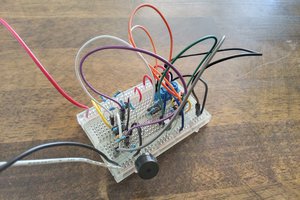Description:
This project is a useful voltage reference for analog circuit experiments and a cool project for analog circuits enthusiasts. With this project you are able to provide a voltage reference in the range of 0.00 to 9.99 VDC.
The project is designed on a PCB. On the top layer of the PCB you will also find the circuit diagram.
Circuit:
The circuit of the adjustable voltage reference is designed as a simple opamp circuit - an inverting amplifier with a old style LM741.
An opamp (IC1) s amplifying a reference voltage of -6.2V.
The reference voltage is created with a 6.2V-zener diode (D1).
The feedback resistor of this inverting amplifier circuit is the pushwheel switch with integrated resistors which works as an adjustable resistor from 0 Ohm to 9.99 kOhms.
A +12V/-12V power supply with the ICL7662 provides the power for the opamp.
The input voltage is +12V DC.
PCB:
I designed a simple PCB. On the black PCB I placed the components including the circuit diagram of this project.
Pushwheel Switch:
A pushwheel switch is a mechanical switch with 10 positions (0-9). The output signal can be in decicmal or BCD code. In this project we need 3 decicmal pushwheel switches.
Each pushwheel switch includes a resistor circuit on a smal PCB in order to get a adjustable resistor in the range of 0 to 9.
The range of the single pushwheels are.
1.digit: 0-90 Ohms (9 resistors with each 10 Ohms)
2.digit: 0-900 Ohms (9 resistors with each 100 Ohms)
3.digit: 0-9000 Ohm (9 resistors with each 1000 Ohms)
All three pushwheel switches in serie result in a adjustable resistor with a range from 0 Ohms to 9990 Ohms. See pushwheel switch circuit diagram.
You can also use a 10 turn potmeter with 10K instead the 3-digit pushwheel switch.
 555Techlab
555Techlab




 ElectroBoy
ElectroBoy
 Sagar 001
Sagar 001
 ElectronicABC
ElectronicABC
An improvement of this is to take the feedback for the zener diode directly from the output of the opamp, and that is a common circuit for 30+ years or so. This way, the zener diode has a constant current (through a resistor from a constant voltage) and thus the zener voltage is independent of the input voltage of the circuit.